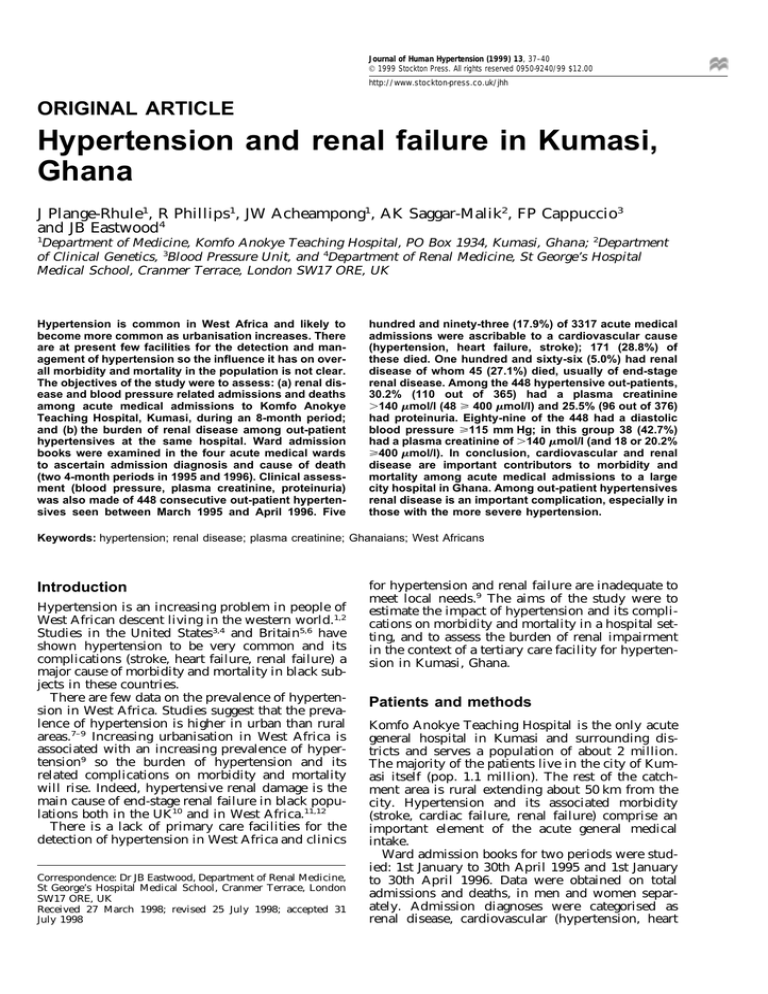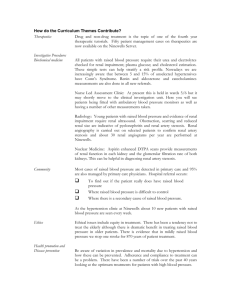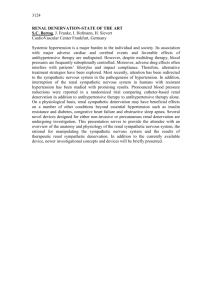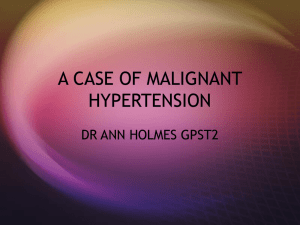Hypertension and renal failure in Kumasi, Ghana ORIGINAL ARTICLE J Plange-Rhule
advertisement

Journal of Human Hypertension (1999) 13, 37–40 1999 Stockton Press. All rights reserved 0950-9240/99 $12.00 http://www.stockton-press.co.uk/jhh ORIGINAL ARTICLE Hypertension and renal failure in Kumasi, Ghana J Plange-Rhule1, R Phillips1, JW Acheampong1, AK Saggar-Malik2, FP Cappuccio3 and JB Eastwood4 1 Department of Medicine, Komfo Anokye Teaching Hospital, PO Box 1934, Kumasi, Ghana; 2Department of Clinical Genetics, 3Blood Pressure Unit, and 4Department of Renal Medicine, St George’s Hospital Medical School, Cranmer Terrace, London SW17 ORE, UK Hypertension is common in West Africa and likely to become more common as urbanisation increases. There are at present few facilities for the detection and management of hypertension so the influence it has on overall morbidity and mortality in the population is not clear. The objectives of the study were to assess: (a) renal disease and blood pressure related admissions and deaths among acute medical admissions to Komfo Anokye Teaching Hospital, Kumasi, during an 8-month period; and (b) the burden of renal disease among out-patient hypertensives at the same hospital. Ward admission books were examined in the four acute medical wards to ascertain admission diagnosis and cause of death (two 4-month periods in 1995 and 1996). Clinical assessment (blood pressure, plasma creatinine, proteinuria) was also made of 448 consecutive out-patient hypertensives seen between March 1995 and April 1996. Five hundred and ninety-three (17.9%) of 3317 acute medical admissions were ascribable to a cardiovascular cause (hypertension, heart failure, stroke); 171 (28.8%) of these died. One hundred and sixty-six (5.0%) had renal disease of whom 45 (27.1%) died, usually of end-stage renal disease. Among the 448 hypertensive out-patients, 30.2% (110 out of 365) had a plasma creatinine ⬎140 mol/l (48 ⭓ 400 mol/l) and 25.5% (96 out of 376) had proteinuria. Eighty-nine of the 448 had a diastolic blood pressure ⭓115 mm Hg; in this group 38 (42.7%) had a plasma creatinine of ⬎140 mol/l (and 18 or 20.2% ⭓400 mol/l). In conclusion, cardiovascular and renal disease are important contributors to morbidity and mortality among acute medical admissions to a large city hospital in Ghana. Among out-patient hypertensives renal disease is an important complication, especially in those with the more severe hypertension. Keywords: hypertension; renal disease; plasma creatinine; Ghanaians; West Africans Introduction Hypertension is an increasing problem in people of West African descent living in the western world.1,2 Studies in the United States3,4 and Britain5,6 have shown hypertension to be very common and its complications (stroke, heart failure, renal failure) a major cause of morbidity and mortality in black subjects in these countries. There are few data on the prevalence of hypertension in West Africa. Studies suggest that the prevalence of hypertension is higher in urban than rural areas.7–9 Increasing urbanisation in West Africa is associated with an increasing prevalence of hypertension9 so the burden of hypertension and its related complications on morbidity and mortality will rise. Indeed, hypertensive renal damage is the main cause of end-stage renal failure in black populations both in the UK10 and in West Africa.11,12 There is a lack of primary care facilities for the detection of hypertension in West Africa and clinics Correspondence: Dr JB Eastwood, Department of Renal Medicine, St George’s Hospital Medical School, Cranmer Terrace, London SW17 ORE, UK Received 27 March 1998; revised 25 July 1998; accepted 31 July 1998 for hypertension and renal failure are inadequate to meet local needs.9 The aims of the study were to estimate the impact of hypertension and its complications on morbidity and mortality in a hospital setting, and to assess the burden of renal impairment in the context of a tertiary care facility for hypertension in Kumasi, Ghana. Patients and methods Komfo Anokye Teaching Hospital is the only acute general hospital in Kumasi and surrounding districts and serves a population of about 2 million. The majority of the patients live in the city of Kumasi itself (pop. 1.1 million). The rest of the catchment area is rural extending about 50 km from the city. Hypertension and its associated morbidity (stroke, cardiac failure, renal failure) comprise an important element of the acute general medical intake. Ward admission books for two periods were studied: 1st January to 30th April 1995 and 1st January to 30th April 1996. Data were obtained on total admissions and deaths, in men and women separately. Admission diagnoses were categorised as renal disease, cardiovascular (hypertension, heart Hypertension and renal failure in Kumasi, Ghana J Plange-Rhule et al 38 failure, stroke) and other, and mortality rates calculated. All patients referred to the Blood Pressure clinic between 14th March 1995 and 16th April 1996 were studied. All were Ghanaian, mostly of the Ashanti tribe. Patients were referred by general physicians, other consultants and medical personnel working in clinics within the catchment area. Many of the patients were referred untreated but others had been prescribed antihypertensive drugs. Patients were seen in an out-patients consulting room. Age and gender were recorded, and all patients were weighed without shoes on electronic scales. They were asked to rest in the sitting position for 5–10 min and three blood pressure (BP) readings were taken with a mercury sphygmomanometer and appropriate cuff. The patients were examined for complications of hypertension including retinopathy. Patients were given laboratory request forms to have urine protein tested (using test strips) and serum creatinine measurements. Results are reported as numbers and proportions (%), mean, s.d., and median when appropriate. Unpaired t-test or the Kruskal–Wallis test were used to compare group means or medians. Chi-square for trend was used to test associations between categorical variables. A P value of ⬍0.05 was taken as statistically significant. Results For the two periods under review, there were 1878 and 1439 in-patient admissions respectively, making a total of 3317 admissions (Table 1). There were no differences between the two periods under review for morbidity and mortality. Therefore, pooled data are presented. Renal disease, high BP and its associated complications were an important cause of admission (22.9% of the total) to the medical wards. The death rate among the admissions was 22.9% (758 among 3319 admissions); 28.5% of these were among those with high BP and its complications, or renal failure. When men and women were examined separately, men had a higher death rate than women (25.2% vs 20.4%; P = 0.0009). Noone died with a diagnosis of ‘heart attack’. Out of 496 referrals to the clinic, 48 patients (9.7%) were excluded because they neither had their BP recorded nor saw a doctor. A total of 448 (163 men and 285 women) patients were available for analysis (Table 2). Body weight in men and women was similar, as were systolic and diastolic BP. Men had higher plasma creatinine values than women, but the proportion with proteinuria in the two groups was similar. The patients were divided into four groups according to diastolic BP. Group 1: 89 patients with BP ⭓115 mm Hg; Group 2: 78 patients with diastolic BP 105–114 mm Hg; Group 3: 118 patients with diastolic BP of 95–104 mm Hg; Group 4: 163 patients with diastolic BP ⭐94 mm Hg. In Group 1 younger individuals were over-represented. Fortynine out of 132 individuals (32.6%) aged less than 45 years had a diastolic BP ⭓115 mm Hg, whereas only 14.6% (46 out of 316) of those aged 45 and over were in the highest diastolic group. Overall, 30.2% of patients had a plasma creatinine of ⬎140 mol/l. The proportion of those with a plasma creatinine ⬎140 mol/l increased significantly with the level of diastolic BP (chi-square for trend = 12.5, P = 0.0004). Furthermore, 48 patients (13.1%) had a creatinine ⭓400 mol/l (18 or 20.2% of those with a diastolic BP ⭓115 mm Hg). A total of 98 (26.4%) out of 371 patients had proteinuria; the proportion of individuals with proteinuria tended to be higher the higher the diastolic BP (chi-square for trend = 2.4, P = 0.12). Discussion In a busy teaching hospital in tropical Africa with approximately 5000 acute medical admissions a year, cardiovascular and renal problems are common causes of admission. This may simply reflect the prevalence of cardiovascular and renal disease in the community, but potential sources of bias must be considered. Factors that might have influenced whether or not acutely sick patients came to the hospital include severity of symptoms, proximity to the hospital, availability of medical advice locally, reliance on traditional healers and, sometimes, economic factors. It is possible that more local (urban) as opposed to rural patients were admitted, as among the rural patients there may have been wide variations in access to transport. Despite the above potential sources of bias, it is clear that car- Table 1 Acute medical admissions and deathsa Men n (%) Women n (%) All n (%) Admissions Renal Cardiovascularb Other 1676 76 (4.5) 271 (16.2) 1329 (79.3) 1641 90 (5.5) 322 (19.6) 1229 (74.9) 3317 166 (5.0) 593 (17.9) 2558 (77.1) Deaths Renal Cardiovascularb Other 423 28 (6.6) 86 (20.3) 309 (73.1) 335c 17 (5.1) 85 (25.4) 233 (69.5) 758 45 (5.9) 171 (22.6) 542 (71.5) a Average of two 4-month periods (Jan–Apr 1995 and Jan–Apr 1996). Hypertension, heart failure, stroke. c Death rate as proportion of admissions: chi-square = 10.9; P = 0.0009 when compared to men. b Hypertension and renal failure in Kumasi, Ghana J Plange-Rhule et al 39 Table 2 Details of the 448 out-patients Variables Men Women All n mean (s.d.) n mean (s.d.) n mean (s.d.) Age (years) Weight (kg) Systolic BP (mm Hg) Diastolic BP (mm Hg) Creatinine (mol/l) median 163 112 163 163 138 284 180 285 285 227 143 51.2 (13.2) 67.5 (17.8) 164.8 (28.0) 101.1 (17.5) 164 (228) 97a n (%) 60 (25.7) 447b 292 448 448 365 Proteinuria 49.2 (12.7) 67.4 (14.2) 165.4 (27.4) 103.2 (18.4) 291 (370) 133 n (%) 36 (25.2) 50.5 (13.0) 67.5 (16.5) 165.0 (27.8) 101.9 (17.9) 212 (296) 120 n (%) 96 (25.5) a 233 376 P ⬍ 0.001 for gender difference by Kruskal–Wallis H Test. One woman did not know her age. b diovascular and renal disease represent a major burden of illness in the community. Hypertension is the most important predictor of stroke, and its adequate treatment leads to a significant reduction in the incidence of stroke in the community.13 On the other hand, the association between hypertension and renal failure, though well-known,10–12 has not had a causative link established.4,14 Circumstantial evidence to date, however, suggests that progression of renal failure can be reduced by treatment of high BP.4 Morbidity and mortality from cardiovascular and renal disease in the community could undoubtedly be improved if facilities for the prevention and treatment of high BP were available.9 There is a serious unmet need among the catchment population of Komfo Anokye Teaching Hospital. About 20% of the new patients in the Blood Pressure clinic had severe hypertension, one-third had a plasma creatinine of ⬎140 mol/l and one in eight had marked renal impairment. Not surprisingly, there was a significant positive correlation between BP and degree of renal impairment. A quarter of the patients tested had significant proteinuria. These findings are of great interest, though possible biases must be considered. There may be overrepresentation of urban patients (proximity effect) and there may have been more patients with severe hypertension owing to the high proportion of hospital referrals. Women comprised 64% of the clinic attenders. This preponderance may simply reflect population structure or there may have been increased awareness of high BP amongst women. Also, Kejetia market, the largest market in West Africa, is within 1 km of Komfo Anokye Teaching Hospital and the majority of the stall-holders and shoppers are women. Furthermore, the hospital itself has a large workforce of doctors, nurses and others, the majority of whom are women. Another possibility is that women may be more willing to listen to advice from doctors and other health workers. The study revealed that there were relatively more young out-patients with severe hypertension. This might be because young people attended the clinic only when they had symptoms. On the other hand, only 14 out-patients were over 75 years of age, possibly because individuals with high BP die prema- turely. In our study 496 patients were registered, issued with case notes and advised of the standard government charge of 1000 cedis (~£0.29). This may be why fewer patients saw the doctors than registered. All patients were given request forms for plasma urea and creatinine and urine protein, adding a further cost of 10 000 cedis (£2.90). Undoubtedly, this second request for money could have been a further reason for the drop in numbers and may have accounted for the finding that only 82% of those who had their BP taken went for a blood test, and only 84% had their urine tested for protein. Furthermore, financial constraints might have influenced many individuals in our study who had been advised to take BP-lowering drugs not to take them. However, it would be difficult to make generalisations about the community as a whole from our data. In conclusion, our study in Ghana shows that hypertension and renal disease are important contributors to morbidity and mortality amongst acute medical admissions and that in a hospital-based outpatient clinic hypertension is associated with a significant burden of renal disease. As recently argued,9 urgent consideration should be given to the deployment of services for the detection, management and control of hypertension and renal disease in West Africa. Acknowledgements The study was supported by a grant from the Association of Physicians of Great Britain and Ireland. We are especially grateful to Professor Eldryd Parry and the Tropical Health and Education Trust, and to Dr Imelda Bates for facilitating the project. We thank Sister Vivian Osei and her staff for their help and assistance, and the four ward sisters for making available and assisting inspection of the admission books. FPC is a member of the St George’s Cardiovascular Research Group. The study was presented at the MRC 50th Anniversary Meeting in Banjul, Gambia in November 1997. References 1 Cooper R et al. The prevalence of hypertension in seven populations of West African origin. Am J Public Health 1997; 87: 160–168. Hypertension and renal failure in Kumasi, Ghana J Plange-Rhule et al 40 2 Cappuccio FP. Ethnicity and cardiovascular disease: variations in people of African ancestry and South Asian origin. J Hum Hypertens 1997; 11: 571–576. 3 Fang J, Madhavan S, Alderman MH. The association between birthplace and mortality from cardiovascular causes among black and white residents of New York City. N Engl J Med 1996; 335: 1545–1551. 4 Klag MJ et al. End-stage renal disease in African-American and White men: 16-year MRFIT findings. JAMA 1997; 277: 1293–1298. 5 Raleigh VS, Kiri V, Balarajan R. Variations in mortality from diabetes mellitus, hypertension and renal disease in England and Wales by country of birth. Health Trends 1996; 28: 122–127. 6 Cappuccio FP et al. Prevalence, detection and management of cardiovascular risk factors in different ethnic groups in South London. Heart 1997; 78: 555–563. 7 Pobee JOM, Belcher DW, Wurapa FK, Dodu SRA. Blood pressure distribution in a rural Ghanaian population. Trans R Soc Trop Med Hyg 1997; 71: 66–72. 8 Kaufman JS et al. The mortality risk associated with 9 10 11 12 13 14 hypertension: preliminary results of a prospective study in rural Nigeria. J Hum Hypertens 1996; 10: 461– 464. Cooper RS et al. Hypertension treatment and control in sub-Saharan Africa: the epidemiological basis for policy. BMJ 1998; 316: 614 –617. Pazianas M et al. Racial origin and primary renal diagnosis in 771 patients with end-stage renal disease. Nephrol Dial Transplant 1991; 6: 931–935. Matekole M et al. Hypertension and end-stage renal failure in tropical Africa. J Hum Hypertens 1993; 7: 443– 446. Njoh J. Complications of hypertension in adult urban Liberians. J Hum Hypertens 1990; 4: 88–90. Du K et al. Case-control study of stroke and the quality of hypertension control in north west England. BMJ 1997; 314: 272–276. Roderick PJ et al. Population need for renal replacement therapy in Thames regions: ethnic dimension. BMJ 1994; 309: 1111–1114.






